November 2nd , 2005
In Depth: The Lancia Flat Fours
Part II: Variants and Series
(In the first article in VeloceToday
we presented the Flavia 1st Series berlina that was introduced to the public at the Autosalon of Turin in 1960. Below is the second part of the Flavia story.)
Sidebar: The Pink and Silver Zagato
Sidebar: Series Two and Three Berlinas
In 1962 the line of the Flavia Berlina was expanded in the well-tested Lancia tradition to include a Coupe, a Convertible and a Sport version. The Flavia Coupe was designed and built by Pininfarina; it was a very elegant well-balanced design that would be dubbed by many the poor man’s Ferrari 250 GT2+2. Giovanni Michelotti designed the Convertible, a rather anonymous 4 seater open tourer with classic lines that somehow resembled the Berlina too much; the coachwork was built by Vignale and hence it became known as the Vignale Convertible.
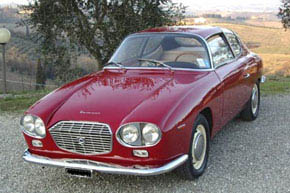
The Flavia
Zagato was unusual on unusual. It still attracts many strange glances from onlookers. (see Zagato sidebar.)
|
The Sport was undoubtedly the most exciting of all of the three variants on the Berlina; it was an all out exercise by Zagato's Ercole Spada, so modern that its lines made the out-of-this-world Citroen DS look conservative. Surely, the Berlina 1st series Flavia, and all of its offshoots, reconfirmed the reputation that Lancia had for out-of-the-box motorcars. The Flavia 1st series Berlina was an extremely well built car, very solid so to speak, the same could not be said of the Coupe, the Convertible and above all the aluminum Sport version, suffered from rather serious issues when it came to rust.
A Class of Their Own
None of the First series Flavias competed with anything of the period; a direct comparison with Alfa Romeos and Fiat's 6-cylinder line of cars of the era - the 1800, 2100 and the 2300 - or for that matter the Mercedeses 219 and 220, the Volvo 122S Amazon, the Auto Union 1000 Sports Coupe, or the Wolseley 6/99 - could not be made. The only car to which the First series Berlina could be honestly compared was the BMW 1500 (and later the 1800) in 4-door sedan version, a model that was crucial in the comeback of BMW as a car manufacturer of prestige.
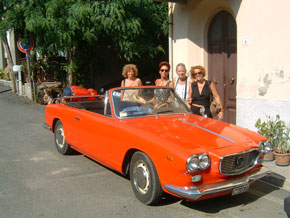
Conservative,
attractive, but not as attractive as the coupe, the Vignale Convertible was
designed by Michelotti.
|
Lancia had clearly priced the Flavias in a class of their own. Irrespective of the model that one could select, Flavias were costly to extremely costly compared to offerings by other car manufacturers, and they sold at a 20% to 50% premium above any and all of the competitors. The Sport was the most expensive version, but then, there was really nothing that could be compared to it! As the US importer, Hoffman Motors Corporation, wrote in its 1962 advertising campaign “In designing the Flavia, cost was a secondary consideration as the primary motive was production of the finest automobile possible, manifesting the most advanced Lancia technique…all of this at prices starting only at $ 3,685.00, fully equipped”. This, of course, was excluding additional costs for delivery as well as the registration, title, tags and sales tax!
Lancia Chic
Lancia targeted the Flavias at the affluent “Bon Chique Bon Genre” (BCBG) motorist, as the French so delicately express this type of clientele! The buyers were traditionalists in life style but had an open mind when it came to innovation! The cars were available in several color schemes (mostly shades of gray - some metallic- and ministerial dark blue, white and an occasional red). Exterior and interior colors were carefully matched. The Berlinas usually had pure woolen upholstery, known as “Panno Lancia”, a cloth of such superior quality that it became the standard for the entire car industry, much like the Conolly leather that was used in the utmost luxurious motorcars of the world.
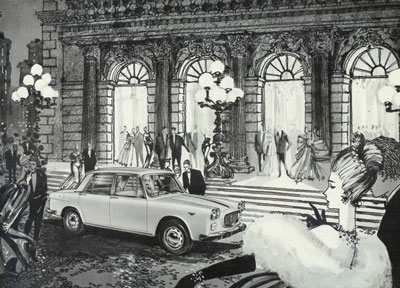
Sophisticated, charming, yet practical, the Flavia was aimed at the upper classes who enjoyed the finer things in life. The price reflected the lifestyle.
|
The Flavia line of cars evoked the lifestyle of the higher echelons of society, a lifestyle that was dominated by fine dining, sailing, horse riding and polo, theaters and opera houses, expensive perfumes, silk scarves and fine ties from the house of Hermes and Gucci, jewelry by Bulgari, and sojourns at famous hotels in the most exquisite places on the European continent! Needless to say that the Lancia organization used all these elements in brochures and its advertising campaign. Famous owners of Flavia Berlinas were HRH Princess Grace of Monaco, Prince Bernhard von Lippe zur Bisterfeld - husband of HM Queen Juliana of the Netherlands - and Karel Woijtyla, later known as Pope John Paul II!
Improving the Breed
The Flavia First series, or the 815 as it was officially numbered, was on Lancia’s catalogue from 1960 to 1967. Initially the production of the First series Flavia Berlina suffered some delays as the new type of Berlina was manufactured in 1961 at the old Borgo San Paolo Lancia factory in Turin alongside the Flaminia and the Appia berlinas. In 1962 production of the First series Flavia Berlina was shifted to the new and ultra-modern factory in Chivasso near Turin. This new factory would later produce the Flavia's smaller sibling and successor to the Appia, and thus the car that gained tremendous popularity as the Fulvia, particularly in the all conquering HF coupe versions.
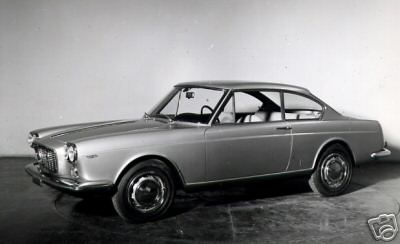
This factory
photo of the Flavia Pininfarina Coupe highlights the simple but elegant lines.
|
In 1963 buyers were given the option of a slightly larger and more powerful 1800 cc version of the flat-four engine that increased output from 78 to 92 horsepower. From 1965 onwards the 1800 cc could be ordered with a Kugelfischer mechanical fuel injection system that increased power output further to 102 horses. The increase in engine displacement gave the carbureted version of the First series 1.8 Berlina a top speed of 160 kilometers or 100 miles per hour, whereas the fuel injected version topped at 168 kilometers or 105 miles per hour. The Flavia Berlina First series was not a small car according to European standards as it measured about 4.6 meters in length and a weighted of 1190 kilograms. The Coupes, Convertibles and the Sport were slightly shorter and only marginally lighter, weighing respectively 1160, 1150, and 1080 kilograms. Top speed of the Coupe and Convertible was identical at 170 kilometers or 106 miles per hour, whereas the Sport would attain 180 kilometers or 112 miles per hour with the 11/42 final drive and 187 kilometers or 115 miles per hour when equipped with the optional 10/37 final drive.
The differences in speed were the result of tweaking of the camshafts and, as in the case of the Sport, the weight loss due to an all aluminum coachwork and the use multiple Weber carburetors that each served a bank of cylinders, thus repeating the set-up experimented and promoted earlier by the famed Lancia tuning magician and race car builder, Edoardo Nardi of Turin.
The Second and Third Series
In 1967 the Flavia First series Berlina was replaced by the 2nd series, also known as the 819. The front end and tail of the Belina Second series were of a completely new design, while the side windows and the doors remained of 815 dimensions. The new design of the Second series Berlina seemed cluttered, particularly in the tail end. The Second series coupe received a sportier instrument panel with round instruments - identical to the one used for the Ferrari 365 GT 2+2, whereas on the outside the cars remained untouched. Mechanicals and measurements of the 819 were essentially the same as those of the 815. Not long after the take-over in 1969 by Fiat, the 819 or Second series Flavia was superseded in 1970, by the 820 series Flavias, all of which mounted a 2000 cc version of the flat-four engine. The first 820 series had coachworks that were identical to the 819 series. It was only with the introduction of the Berlina 2000, when Lancia dropped the name Flavia, that the design of the car changed. The Berlina 2000 was officially a 829 series and therefore this third series can be considered the last of the Flavias. In effect, the 2000 Lancias were third, and last series of the Flavia. See sidebar for details of the second and third series Berlinas.
Last of the Breed, the Gamma
In the their final run, the flat four engines were mounted in heavily modified form in a completely new car, the prestigious Gamma Berlina and Coupe. These Gammas came with 2000 cc displacement for mainly the Italian market and the larger 2500 cc engines targeted at export markets. The elegant design of both Gamma Berlina and Coupe was by Pininfarina.
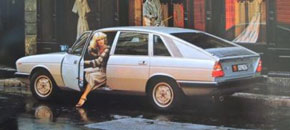
Lancia Gamma sedan, large, luxurious and a wee bit overweight, but a fast Autobahncruiser nevertheless.
|
Quite remarkably, FIAT management had chosen the new prestigious Gamma Berlina to be a “two box car”, and thus a car that did not have a real trunk in the traditional sense. While this trend reflected Italian car design of the period (first introduced at Lancia with the heavily FIAT based Boano-designed new Beta Berlinas) it was a characteristic that was not shared - with the exception of the Rover and the Citroen CX - by any of the other luxury car manufacturers of the era, such as Mercedes Benz, BMW or Jaguar. The Gamma line of cars was designed by Pininfarina, the Berlina being a clear descendent of a BLMC 1100 that Pininfarina designed years earlier, whereas the Coupe had lines that would be rediscovered in the Cadillac Allante. The fact that the Gamma was a 4-cylinder car did not make it a strong contender either in a luxury car market dominated by 6 cylinders.
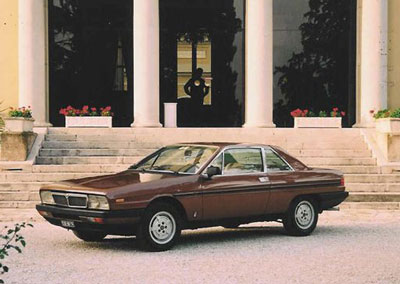
The last of the famous Fessia flat fours. Was the Gamma Lancia's Cadillac Allante?
|
By the mid-1980’s the Lancia Gamma line of cars was retired and from then onwards the flat-four engine became history as far as it concerned the make of Lancia. Those who wanted to enjoy a drive in Italian cars with water-cooled horizontally opposed cylinder engines had from then onwards to rely on the little Alfasuds or else on the Ferrari Boxers and Testarossas - which may explain the success of Subarus and - much later - the water-cooled Porsches!
In Part III we will see how to buy a Lancia Flavia Berlina, parts and
check out restoration services.



